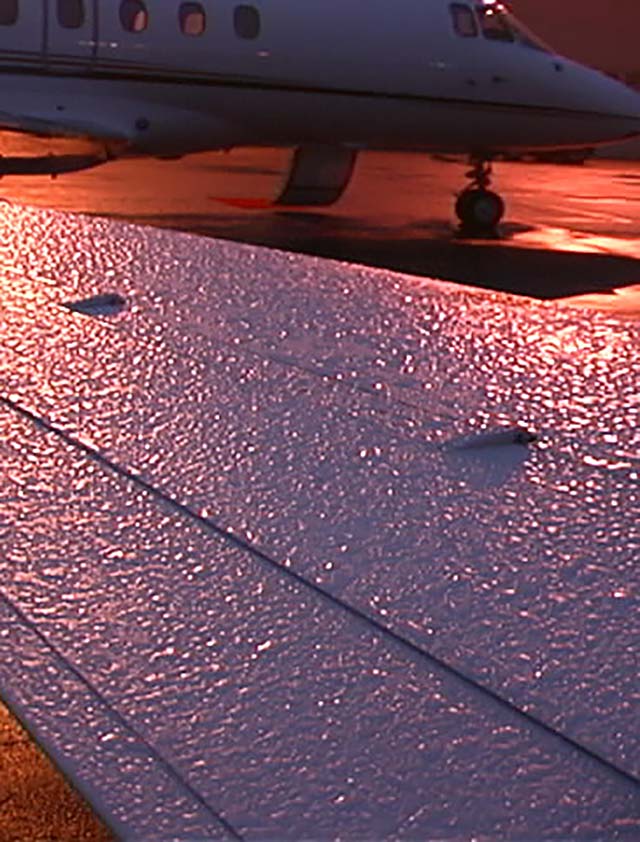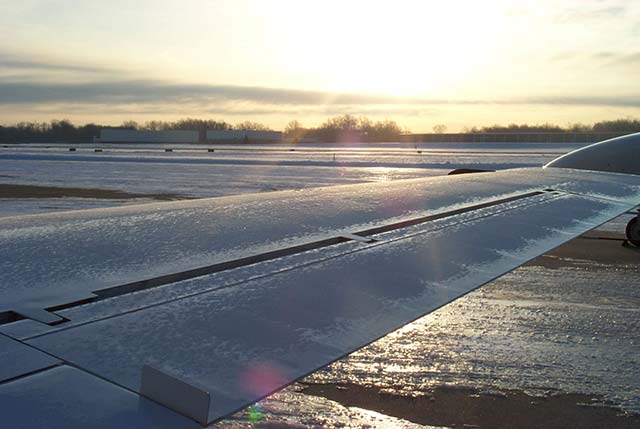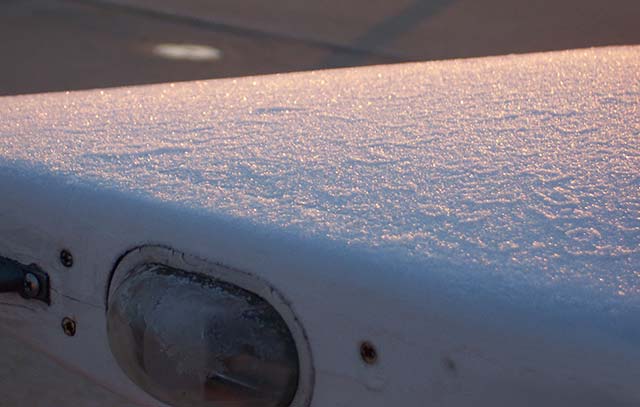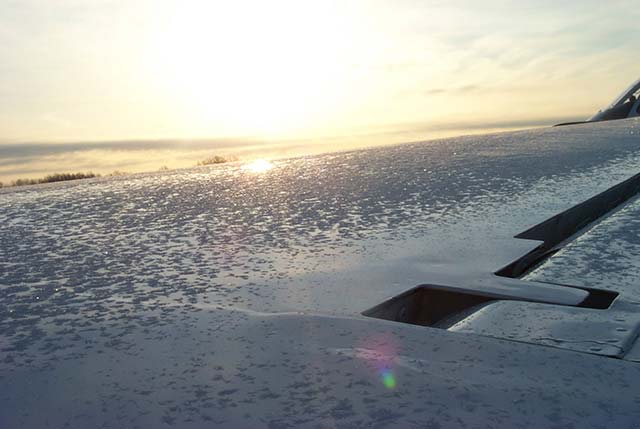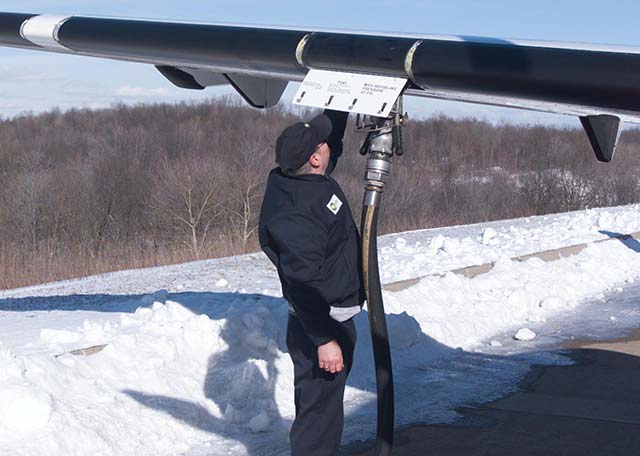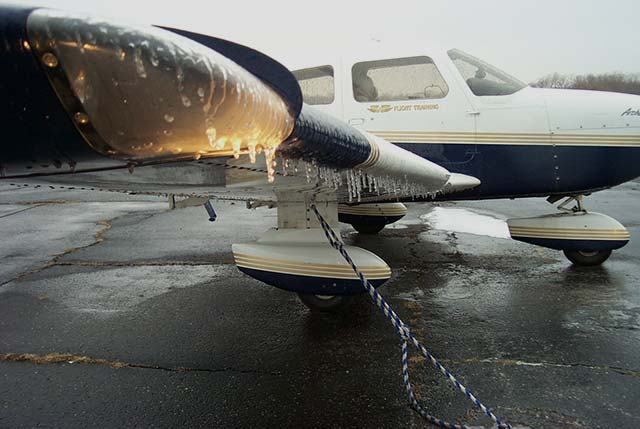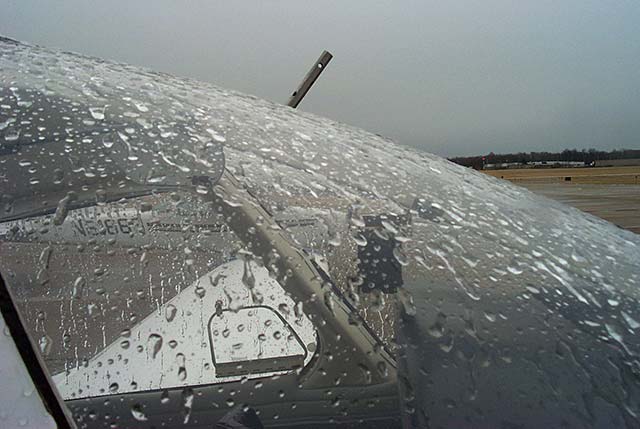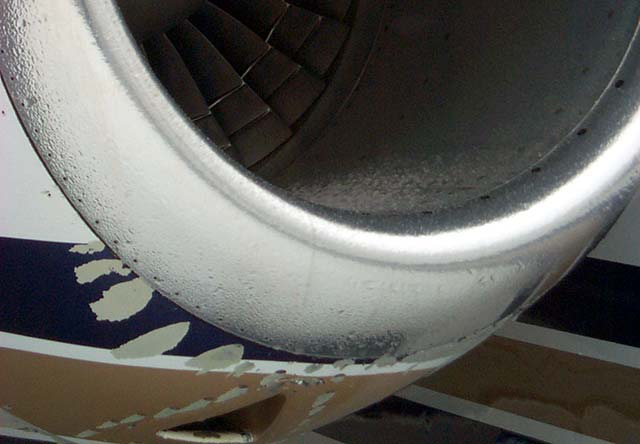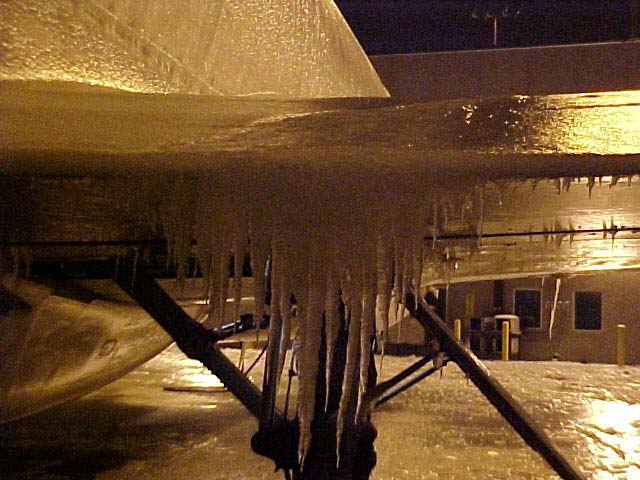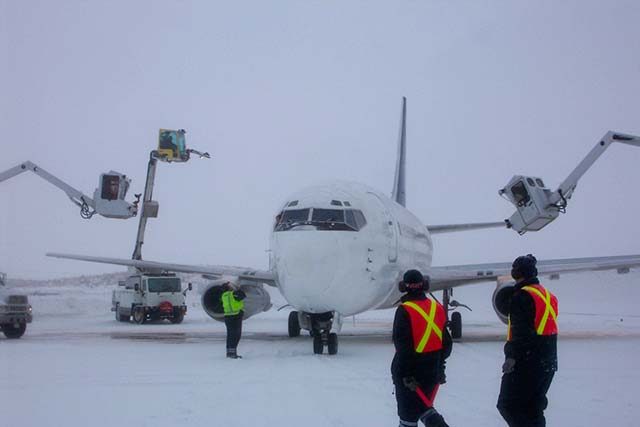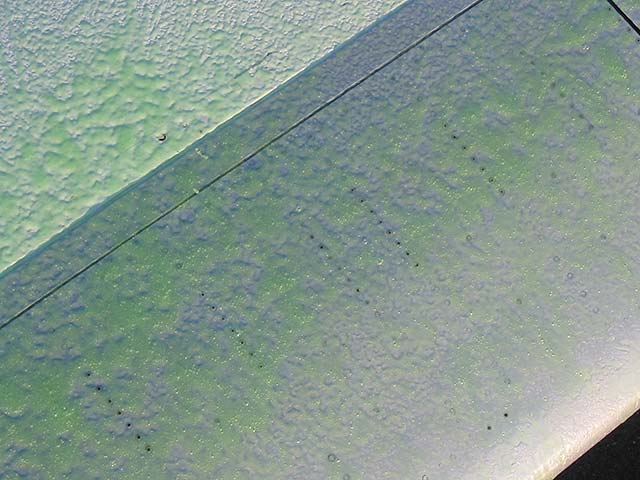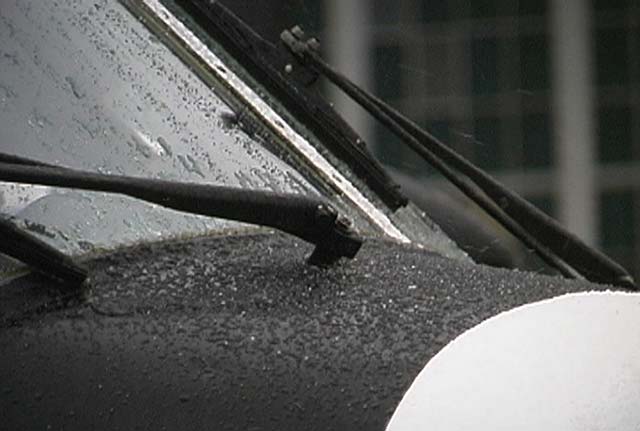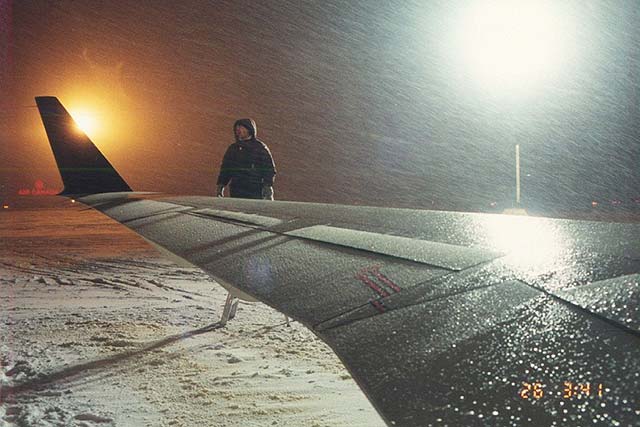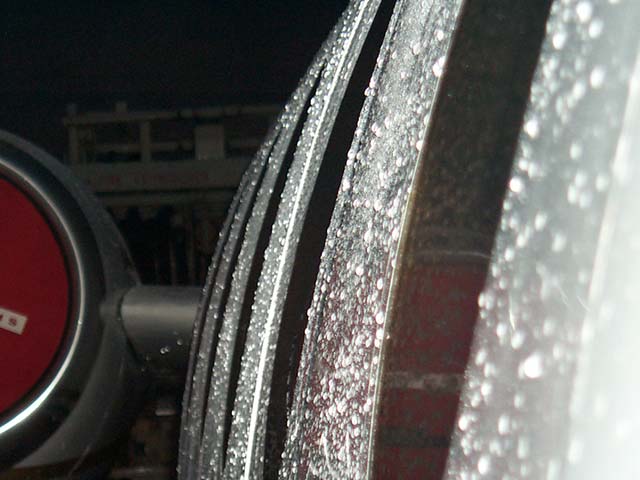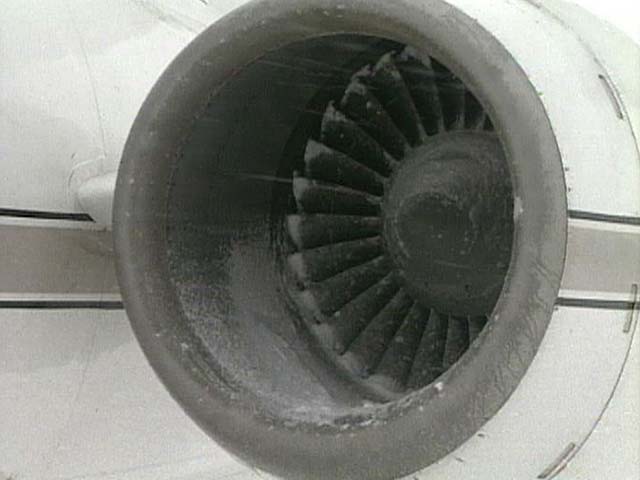A Pilot's Guide to Ground Icing
Module II - Cues
How to tell when you should worry
Section: Anticipating Contamination
Start This SectionAnticipating Contamination Cues
While planning your flight, check the forecast at your departure, destination and alternate airports for frost* or freezing precipitation. Check the de-icing and anti-icing capabilities at airports where you may encounter these conditions.
In this section, we’ll discuss what you need to know to anticipate ground icing conditions, and several free sources where you can find this information. Specifically, we’ll discuss:
- Frost
- Hoar Frost
- Active Frost
- Cold Soak Fuel Frost
- Freezing Precipitation
- Freezing Fog (FZFG)
- Snow (SN)
- Freezing Drizzle (FZDZ)
- Freezing Rain (FZRA)
- Ice Pellets (PL)
*The US Government provides data for frost prediction free of charge
Anticipating Contamination Cues
Frost
Hoar frost appears as a thin, uniform deposit of ice with a fine, white, crystalline texture. It will need to be removed prior to flight, but will not reform.
Active frost is similar to hoar frost, but continuously reforms. Active frost can only be removed with de/anti-icing fluids.
Hoar frost and active frost form under the same conditions.
Related Information
ST.MARYS, PA – USA
NOVEMBER 14, 1987
MOONEY 20-C
While getting fuel, the pilot of the Mooney M20C and his 3 pals were attempting to remove frost with paper towels and plastic credit cards after being told by the fuel truck driver that the airport had no ice removal solution. A witness stated that as the attempt was being made to remove the frost and ice, more frost and ice was forming. Witnesses who observed the aircraft on the takeoff stated the roll was very long; the climb and turning bank was steep; and that the aircraft descent angle was steep. The aircraft collided with trees and burst into flames.
Anticipating Contamination Cues
Frost
Expect frost to form on your aircraft if temperatures are cold enough and there is sufficient moisture.
Specifically:
- the aircraft skin temperature is below freezing (Note – the aircraft skin temperature can be colder than ambient due to radiation cooling or cold soak fuel.)
- the air temperature is close to the dew point temperature (within 3°C or 5°F)
- the dew point is below freezing
And either one of these conditions is/was present:
- a cloudless sky with calm winds1
- a warm front bringing warm, moist air2
1 due to the radiation cooling mechanism
2 due to the advection mechanism
Further Information
Although frost is not currently forecasted in aviation-related weather products, you can query people at the airports you intend to use. They might have a good idea based upon experience or local weather reports.

In the U.S., the National Weather Service provides current and forecasted information on the frost parameters: temperature, dew point, sky coverage and wind speed. This information appears on the Graphical Forecast tab.
Realize that this data grid is spatially coarse. The actual frost parameters at your airport(s) may vary, especially if in a low lying area between stations.
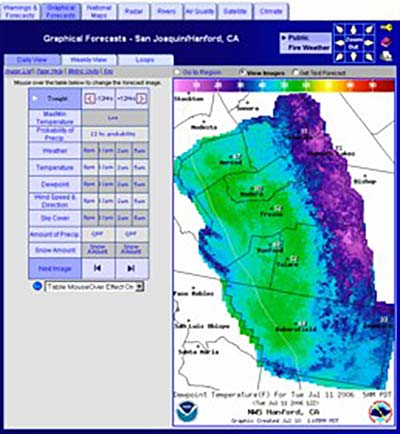
Sample screen of forecasted dew point from the United States National Weather Service web site.
Related Information
Pilot Tom Schultz discusses delaying departure due to frost
Anticipating Contamination Cues
Cold Soak Fuel Frost
Moisture in the form of precipitation or high humidity (where the temperature-dew point spread is within a few degrees), can deposit frost or ice on a cold wing, even in a fairly warm environment.
This situation tends to occur when the fuel is cold soaked, and in contact with the aircraft skin. Fuel can become cold soaked by an extended exposure to a very cold environment, either on the ground or in the air.
Be sure to check the top and bottom of the wing for contamination due to cold soak effects. Don't be fooled by what appears to be water on the wing. It may actually be ice.
Related Information
TORINO, ITALY
FEBRUARY 16, 2002
F-70
On February 16, 2002, the flight was scheduled to depart from Caselle Airport in Torino at 05.50 UTC for Schiphol Airport in Amsterdam. During the pre-flight inspection the Captain decided that the aircraft needed to be de-iced. After the de-icing operation the aircraft was visually inspected by the Captain.
During rotation the left engine (No.1) developed fan vibration followed immediately by the failure of the right engine (No.2) at lift off. The crew executed a right hand turn at 1.500 feet QNH and proceeded to a holding fix to prepare for a single engine return to Torino. A PAN PAN PAN call was transmitted. When executing the emergency procedure for the failed engine the first officer could not move the fuel lever to the closed position. Apart from the engine failure, the crew had to deal with an Autothrottle alert, Cabin Pressure alert, Fuel Asymmetry alert, Centre Tank Pumps alert, a Vibration High Engine 1 alert and an Icing alert.
Causes:
The crew did not draw the conclusion that the wings were cold soaked and so the formation of clear ice was not suspected. Clear ice was not detected on the upper surface of the wings. Clear ice was not removed from the upper surface of the wings. After the de-icing operation a tactile check was not performed to check for the removal of all ice from the wings.
The primary cause of the event was the ingestion of ice by both engines which caused the right engine to fail completely and the left engine to develop high fan vibration.
Anticipating Contamination Cues
Freezing Precipitation
If you are savvy enough to anticipate ground icing conditions, you can take steps to protect your aircraft, and/or plan ahead for your de/anti-icing needs.
If freezing precipitation (snow, freezing fog, freezing rain, freezing drizzle, or ice pellets) can stick to your aircraft, and your aircraft is not certified for flight in known icing, you should delay departure.
Information regarding freezing precipitation can be found in the METAR or TAF. Don’t be tricked into complacency by reported rain or drizzle at near freezing temperatures, as this, too, could stick to your aircraft.
Anticipating Contamination Cues
Freezing Fog (FZFG)
Contact between freezing fog and the surface of your aircraft can be enough to phase change the supercooled water droplets to ice, that adheres to the aircraft surfaces.
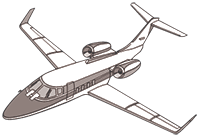
Taxiing through freezing fog can result in ice formation inside the engine inlet and possibly on the fan blades.
Further Information
Fog is generated by a number of mechanisms. The essential element is that the air temperature and dew point become nearly identical (within 3°C or 5°F). This causes the vapor in the air to condense into the suspended water droplets of fog. Fog always implies reduced visibility: less than 1000 m (0.6 SM) and, in heavy fog, less than 100 m (220 yards).
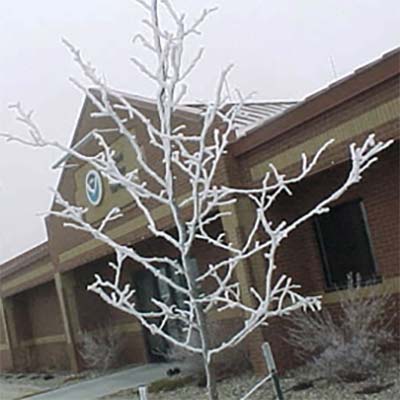
Freezing fog coating on ground cover and small tree.
Related Information
Aircraft was in unheated hangar overnight. OAT approx 8 degs F in fog. We removed aircraft from hangar. Added fuel. Startup and taxi normal. Because of the very cold temps, IMC dep (clearance was to pick up IFT at alt because of Truckee's location relative to surrounding high terrain). We performed a very thorough, detailed run-up. We did notice what sounded like a small piece of ice hitting the fuselage when checking the magnetos. This raised the question of whether or not the props had accumulated ice during taxi, even though the prop heat had been on since startup. Because we were able to verify (via prop amps) that prop deice was operative, we assumed there was no significant ice accumulation on the props and taxied onto the runway for departure. Our turn to line up on the runway put sunlight on the copilot side of the aircraft (it was sunrise), and I noticed frost on the wings. The pilot and I discussed this finding and I offered to wipe the frost off.
He shut down the right engine and I found substantial prop and air frame ice accumulations. The air frame icing consisted of frost on upper wing surface and mixed rime and clear ice on engine nacelles, vertical stab, horizontal stab. Of particular interest was the ice accumulation on the underside of the horizontal stab - - the side most critical to flight. There was also frost on the upper surface of horizontal stab. There was significant prop ice, as follows: approximately 1/3 inch on leading edges outboard of prop boots (clear ice), 1/4 - 1/3 inches mixed ice on back of prop blades, some clear ice on front of prop blades.
There are several points to consider about our findings: 1) we assumed the fog was frozen and therefore of no threat as regards air frame or prop icing. Structural ice on the ground (with exception of during precip) had never occurred to me. 2) The aircraft was 200 lbs under max gross wt of 6200 lbs. The takeoff performance would have been compromised - - perhaps seriously - - had we attempted to depart carrying that much ice. 3) Had we experienced even partial power loss, single eng climb would have been unlikely, particularly considering terrain. 4) Not one pilot I've asked would have suspected structural ice in those conditions. 5) An SMT had crashed 1 wk prior to our incident on takeoff under virtually identical conditions (even time of day). I believe the NTSB should consider our (more fortunate) experience in its investigation, particularly if other causes (power loss, etc.) are not conclusive.
Callback conversation with reporter revealed the following info: Reporter states this was the most shocking and sobering experience of his life. Feels if they had tried a takeoff it would not have worked. They were more than 200 lbs under gross but the ice would probably have prevented lift enough to get airborne. In speaking with many other experienced pilots they all are of the same feeling that they would not have expected air frame icing to occur on the ground in such temps. Chipping ice off the air frame in 8 deg WX is not much fun but he is extremely pleased they were able to do that instead of being picked up in pieces. Callback specifically made to suggest to reporter that he contact NTSB with this info since previous accident so similar.
Anticipating Contamination Cues
Snow (SN)
Snow, snow grains (SG) and snow pellets (GS) are readily forecasted.
Depending on the moisture content of the snow and temperature/condition of your aircraft skin, it may or may not stick to your aircraft.
To anticipate the go/delay/no-go decision, or which anti-icing fluid to use, you need to know the snowfall intensity. This comes from the visibility, outside air temperature, and the day/night lighting conditions.
Further Information
Snow pellets are white, opaque grains of ice. The particles are round or sometimes conical; their diameter ranges from about 2-5 mm (0.08-0.2 in.). Snow pellets are brittle and easily crushed; they do bounce and may break on hard ground. Holdover times have not been evaluated for snow pellets, primarily due to the difficulty of testing in natural snow pellet conditions. Snow pellets tend to fall in showers of brief duration. It is known that snow pellets have a fairly low density of 0.2 g/m3, whereas ice pellets are four times denser, 0.8 g/m3.
Snow grains are very small white and opaque particles of ice that are fairly flat or elongated with a diameter of less than 1 mm (0.04 in.). When snow grains hit hard ground, they do not bounce or shatter. NOTE: For holdover time purposes treat snow grains as snow.
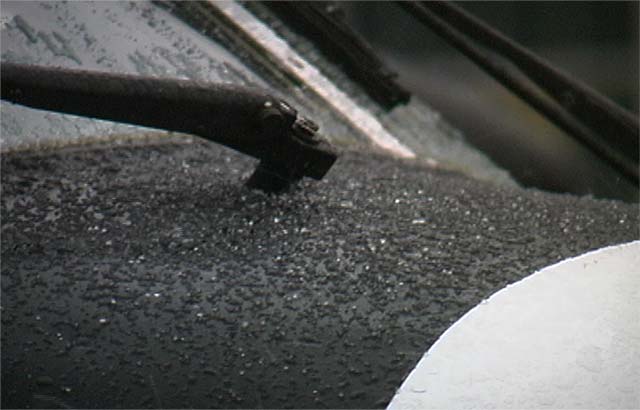
Snow pellets striking aircraft nose and cockpit
Snowfall at near freezing temperatures, roughly -2°C to +2°C is likely to have very high moisture content, and can stick to your airframe. It is unlikely to “blow off” during the takeoff roll.
On the other hand, snow at very cold temperatures, roughly -10°C, will not stick to a cold, dry aircraft.
Be sure to check your wings carefully if covered in snow (via a tactile inspection), as it can conceal a layer of ice. Too many accidents have occurred when the pilot attempts takeoff after removing the layer of snow, but not the layer of ice underneath.
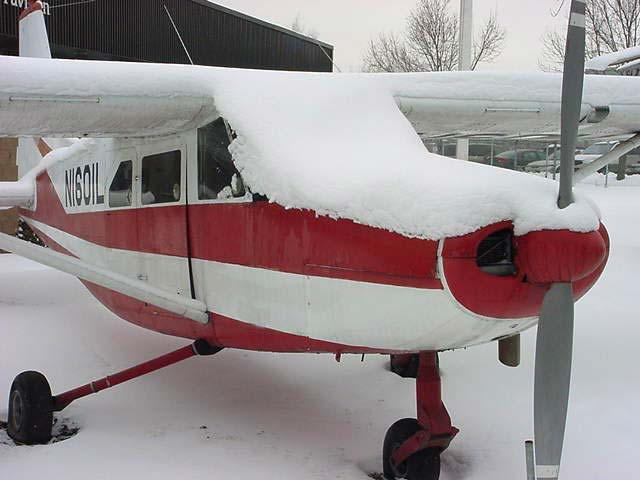
Snow and ice contamination on a single engine aircraft.
One issue to be aware of is the discrepancy in snowfall intensity rate reported by meteorologists, e.g, METAR, TAF, ATIS, AWOS or ASOS, and that used by researchers conducting anti-icing fluid testing. The primary factor in determining anti-icing fluid holdover times, and therefore what you as PIC should be aware of, is the moisture content of the snow. The Snow Intensity vs Visibility chapter in Module 5: Anti-icing Operations describes a way you can accurately determine the snowfall intensity to use the correct holdover times.

Two snow crystals with different moisture content.
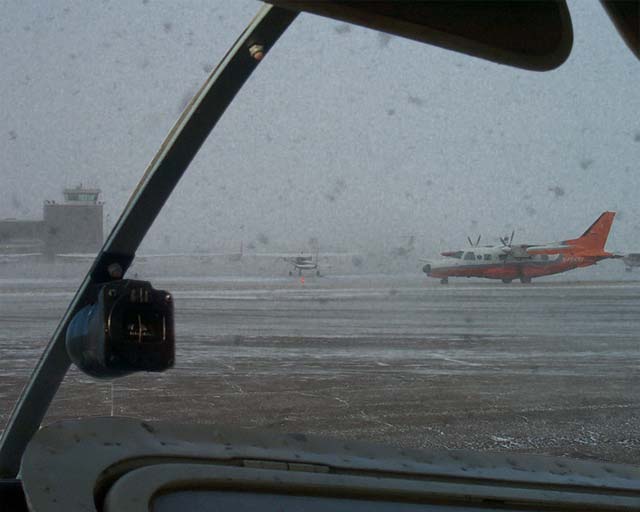
Moderate snowfall intensity, airport building in background
Related Information
HUNTINGTON, WV – USA
JANUARY 31, 1985
BE-18
3-4 Inch snow accumulation on acft prior to flt. Pilot said he swept snow off except an area he could not reach. Heavy snowfall, wet snow reported as acft was prepared for departure, during run-up, taxi, and takeoff. Pilot advised by tower that visibility was 1/8 mile with fog and snow. Published takeoff minimum for FAR 135 operations was 1/2 mile. After striking snowplow located 150 feet left of rwy. Acft continued over embankment and came to rest inverted. Ice and snow found on upper tail surface. Elevator trim indicated full nose dn. Aileron trim ind left bank. Witnesses said engines sounded normal, landing lights on, 600 feet visibility from position of snowplow. Pilot said 35 inches map when descending. Map increased with additional throttle. No engine roughness.
JOHNSON CITY, NY – USA
APRIL 2, 1985
C-421
The aircraft was on a flight from Johnson City, New York to Toledo, Ohio. After a heavy snow shower passed over the airport, the accident aircraft attempted a departure. Immediately after take-off the pilot transmitted that he was coming back to land.
The aircraft crashed shortly thereafter, 1 mile southwest of the airport. Ground witnesses observed the aircraft use nearly all of the 4,999 ft runway and gradually descend out of sight prior to the crash. A Cessna Conquest had departed the same runway moments prior to the accident aircraft and had experienced directional control problems due to slush on the runway and airframe icing on their aircraft.
Anticipating Contamination Cues
Freezing Rain (FZRA) & Freezing Drizzle (FZDZ)
Both freezing rain and freezing drizzle are forecasted, but also watch for rain or drizzle at near freezing temperatures.
These forms of freezing precipitation are particularly hazardous both on the ground and in the air. Besides leaving a layer of ice that can be difficult to remove, and a challenge to protect against (with anti-icing fluids), your in-flight ice protection system may not be able to adequately protect your aircraft either.
Further Information
Freezing rain and freezing drizzle consist of large super-cooled liquid water drops that are much larger than typical cloud-sized or fog droplets. These supercooled large drops (SLD) can freeze after impact with an unprotected surface.
Freezing rain drops are larger than freezing drizzle drops, and tend to fall in a straight line trajectory. The smaller drops of freezing drizzle may drift in the air currents.
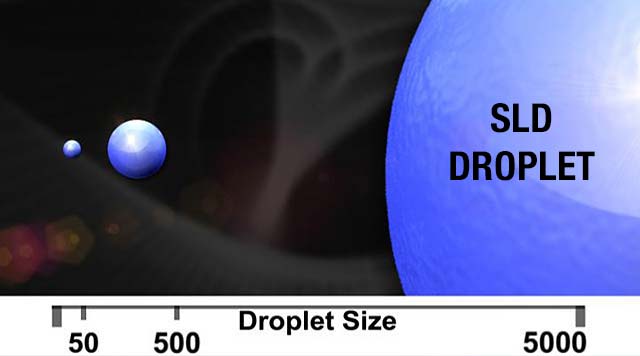
Typical cloud-sized droplet (smallest) compared to FZDZ (medium) and FZRA (largest) drops.
Freezing rain is typically formed by the temperature inversion mechanism, which is usually associated with warm and stationary fronts. Ahead of these fronts, snow falls into above-freezing air and melts, forming liquid precipitation. The liquid precipitation continues to fall into freezing temperatures below, forming freezing rain and, occasionally, freezing drizzle. In some cases, the rain or drizzle freezes to form ice pellets that fall to the surface.
In this case, the greatest potential for encountering SLD is from the bottom of the above-freezing layer all the way to the surface. Research indicates this layer is generally less than 3000 ft deep, but has been observed up to 7000 ft deep.
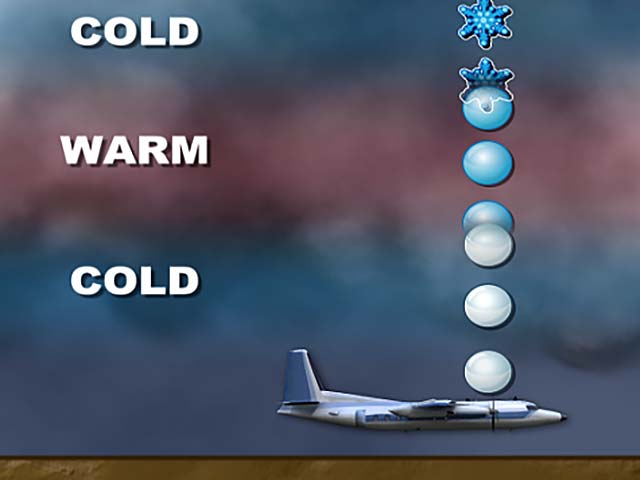
The temperature inversion formation mechanism
Freezing drizzle is typically formed by the collision-coalescence mechanism. This process occurs when droplets collide within a cloud, and coalesce into larger droplets. Pilots are much more likely to encounter this form of SLD.
Research has shown that SLD clouds of this type are usually relatively warm, low-altitude clouds. Look for cloud top heights below 12,000 ft, and cloud top temperatures warmer than about –12°C (mnemonic: 12/12). In this case, the SLD layer is usually less than 3000 feet deep. Be aware, however, that this type of SLD can occur above 12,000 feet.

The collision-coalescence formation mechanism
If you expect freezing rain or freezing drizzle during your ground stay, you can save significant time and de-icing expense by protecting your aircraft. If hangar space or wing covers are not available, some operators chose to apply a preventative layer of de/anti-icing fluid.
If these conditions are present during your intended departure time, make sure it is operationally feasible to anti-ice and depart within the holdover time (which can be as little as 2 min with Type I fluid). Once airborne, anti-icing fluids will not protect you, and your in-flight ice protection system may not adequately protect your aircraft either. Unless you have specific guidance from the manufacturer, takeoff is NOT recommended.
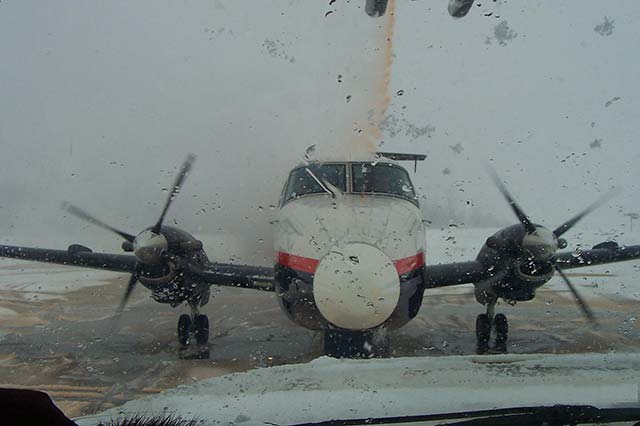
Make sure it is operationally feasible to de/anti-ice and depart within the holdover time.

Illustration of typical cloud-sized droplet (smallest), FZDZ (medium), and FZRA (largest) drops.
Related Information
SOMERSET, PA – USA
JANUARY 19, 1982
PA-60
The aircrew intended to depart at 1600 EST, but due to the General Aviation Reservation Restrictions, the flight was delayed until 1700. The pilot reported the takeoff was normal until just before rotation at 85 to 90 kts, when Freezing Rain began to obscure the windshield visibility. At lift-off, the aircraft began to roll left. The pilot applied rudder and aileron to correct the roll, at which time the airspeed dissipated and the aircraft settled back to the runway. He reported initiating rotation again at 90 kts and the aircraft rolled left again. The left main gear struck a frozen snow plow rut and separated when the aircraft touched down beside the runway.
MORRISONVILLE, NY – USA
MARCH 19, 1984
BE-18
The aircraft was on a flight from Morrisonville, New York to Syracuse, New York. The pilot landed on the ice and snow covered runway. After loading 1,512 lbs of cargo in freezing drizzle conditions, he taxied for take-off for an IFR departure. Shortly after rotation, the right wing dropped and the aircraft touched down back on the runway. Visual examination of the aircraft revealed ice accumulations on the leading edges and upper wing surfaces.
The pilot had attempted to get de-icing equipment, which was not available but was offered the use of a hangar which he declined. The airport manager was en-route to check runway conditions for ploughing the ice and snow covered runway when the pilot returned to the aircraft. An unsuccessful attempt was made to remove ice from the leading edges by hand. The pilot decided to attempt another take-off and at this time was almost 30 minutes beyond his scheduled departure time. Lift-off was approximately 20% of the way down the runway and, after flying at 50 ft AGL a climb was initiated. After attaining an altitude of several hundred feet, the aircraft stalled and descended uncontrolled to impact. The aircraft was destroyed by impact and fire and the pilot was fatally injured.
GANDER, NEWFOUNDLAND – CANADA
DECEMBER 12, 1985
DC-8
The accident flight arrived at Gander at 0904. Passengers were deplaned, the aircraft was refueled, and supplies were loaded. Prior to reboarding the passengers, the flight engineer was seen conducting a visual inspection of the external portions of the aircraft. Weather at Gander included light freezing drizzle, snow grains or snow; a ceiling of 366 meters (1,200 feet); and visibility of 16 kilometers (10 miles). OAT was -4 degrees C (26 degrees F). The aircraft was not deiced before takeoff, although airport authorities later reported that other aircraft taking off from Gander that morning had requested deicing. Witnesses to the takeoff reported that the aircraft gained little altitude after rotation. Other witnesses said that the aircraft pitched up and entered a right bank as it crossed over the end of the airfield. The aircraft struck downsloping terrain about one kilometer (3,000 feet) beyond the end of the runway and was destroyed by postaccident fire.
The official accident report concluded that during the aircraft’s approach to Gander, weather conditions were conducive to ice accretion on the leading edges of the wings; and that while on the ground at Gander, the aircraft was exposed to freezing and frozen precipitation capable of causing roughening on the upper wing surfaces. The report cited as the most probable cause of the accident an increase in drag and reduction in lift that resulted in a stall at higher-than-normal airspeed at an altitude so low that recovery was impossible.
The most probable cause of the stall was cited as ice contamination on the leading edges and upper surfaces of the wing. Pilot’s qualifications: AT, IR with 7,001 total hours of flight time, with 1,081 hours in type. Copilot’s qualifications: C, IR with 5,549 total hours of flight time, with 918 hours in type.
Anticipating Contamination Cues
Ice Pellets (PL)
Do not attempt to depart in ice pellet conditions. Ice pellets can cause rapid failure of an anti-icing fluid because they readily penetrate through the fluid and are much denser than other precipitation types for which holdover times have been measured.
Further Information
Ice pellets include two fundamentally different types of precipitation that have recently been recognized internationally. In the United States, ice pellets were known as (a) sleet, or grains of ice, and (b) small hail.
Ice pellets are sometimes formed in the temperature inversion associated with a warm or stationary front. Liquid precipitation freezes as it falls into below-freezing air near the surface.
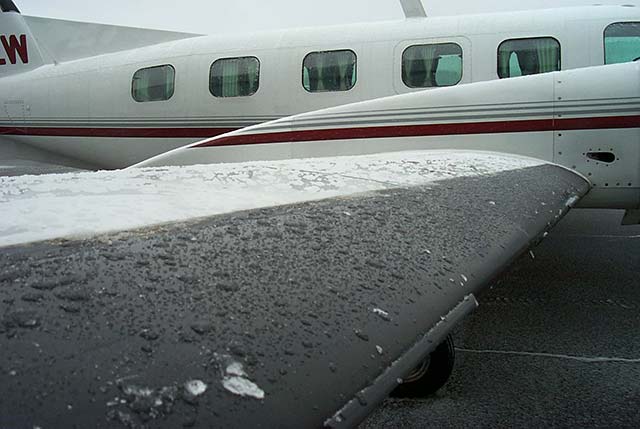
Residual effects of ice pellets striking an aircraft wing and fuselage.
Related Information
PHILADELPHIA, PA – USA
FEBRUARY 5, 1985
DC-9
The aircraft was on a flight from Philadelphia, Pennsylvania to Wilmington, Ohio. After landing at Philadelphia the aircraft was parked on the ramp for approximately 39 minutes to load cargo. During that time, light freezing drizzle was falling, intermittently mixed with ice pellets and snow. The crew checked the aircraft surfaces from the cockpit and entry door but observed no ice or snow adhering to the tops of the wings, nose section, windshield or above the door. The Captain declined an offer to de-ice, though other aircraft were being de-iced.
The take-off was normal (18 degrees nose up attitude) until just after lift-off, then the aircraft entered an uncommanded left roll and both engines suffered a compressor stall. The Captain corrected with left aileron and rudder, then began aborting the take-off. The aircraft touched down left of the runway on the tail skid and right wing tip, approximately 5,600 ft from the threshold and on a 70 degree heading. It then traveled another 2,025 ft in a sweeping right arc, hitting 2 runway signs and came to rest heading west with the right pylon bent down. Investigation revealed a thin layer of ice (approximately 0.15 inches thick) would have been on the wings, raising the aircraft's stall speed. When DC-9-15 aircraft stall, the engines are susceptible to compressor stalls.
Anticipating Contamination Cues
There are some conditions that will likely exceed your ability to protect your aircraft on the ground and in the air.
Do not attempt to take off in the following:
- Moderate to heavy freezing rain
- Heavy snowfall
- Ice pellets
Holdover times also have not been evaluated for snow pellets (GS).
Anticipating Contamination Cues

If you have just flown through "heavy" precipitation consider inspecting the engine intake areas for ice or water immediately after shutdown. Any water that freezes in the inlet poses a FOD hazard, or could cause the compressor to freeze. Such accumulations should be removed while the engine is cooling and before installing plugs and covers.
